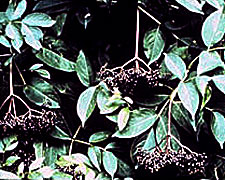
Since 1999, there has been an elderberry study underway at the University of Missouri’s Southwest Research Center near Mt. Vernon. Funded, in part by a grant from the United States Department of Agriculture, the study focuses on determining which elderberry cultivar grows best in southwest Missouri. Not as popular as strawberries, blackberries or blueberries, the elderberry is actually a native Missouri shrub that produces an edible purple fruit native to the Ozarks.
Some of the cultivars being used in the research were obtained from New York and Canada. Those plants are showing signs of not doing well in the Missouri climate, according to Andrew Thomas, horticulture research associated, University of Missouri. The study, which Thomas said stemmed from a renewed interest in alternative but native Ozark fruits, also includes more than 40 elderberry plants gathered from different locations in Missouri, Kansas and Oklahoma.
“The ultimate goal of the study is to release a named variety or two of elderberries that will grow very well in Missouri. I’m pretty confident we can do that,” said Thomas.
Thomas is gathering information on the growth, vigor, cane production and disease and insect susceptibility of the berries. This research project also is being replicated by Pat Byers at the SMSU Fruit Experiment Station in Mountain Grove, MO. Thomas expects the experiment to continue over the next four or five years.
“The focus of our study is to learn how to grow elderberries to get the optimum yield,” said Thomas. “We are also looking to see if pruning is a better option or if brush hogging it to the ground every year and then letting it grow up in stages produces a higher yield. This is probably the largest elderberry research project going on in the country right now. We believe the elderberry has good potential as a commercial fruit crop in Missouri, but many basic questions related to its culture remain unanswered.”
According to Thomas, basic research, combined with development of high-quality products and creative marketing by producers could make this tough, native plant an important part of an increasingly-diversified Missouri agriculture.
The fruit, which is rich in vitamins, iron, potassium and protein, makes excellent jellies, syrups, desserts, and food colorings. The flowers are also edible, often prepared as fritters or used to flavor jellies and wines. The bark, leaves, flowers, and fruit all have medicinal properties and have been used for thousands of years to treat a variety of ailments.
One successful example of elderberry wine production exists in Wichita, Kansas, where a winery is using 130,000 pounds of elderberries a year to produce a high quality wine that has been competing with California grape wines. Elderberries are particularly suited to wine-making because of their ideal balance of tannins, acids and sugars, and their deep purple color.
You can learn more about the Elderberry research project at the 25th Annual Missouri Small Fruit and Vegetable Conference, Feb. 21–23, 2005 in Springfield. This event is jointly organized by Southwest Missouri State University and University of Missouri Extension.
More information (including a schedule and registration information) can be found online. You may also contact Patrick Byers, SMSU Department of Fruit Science at (417) 417-926-4105 or Pamela Mayer at (417) 926-4105 to register or for information on registration fees.






Comments